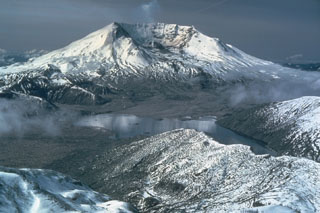Report on St. Helens (United States) — October 1985
Scientific Event Alert Network Bulletin, vol. 10, no. 10 (October 1985)
Managing Editor: Lindsay McClelland.
St. Helens (United States) Activity at background level; magnetic data on May-June dome building eruption
Please cite this report as:
Global Volcanism Program, 1985. Report on St. Helens (United States) (McClelland, L., ed.). Scientific Event Alert Network Bulletin, 10:10. Smithsonian Institution. https://doi.org/10.5479/si.GVP.SEAN198510-321050
St. Helens
United States
46.2°N, 122.18°W; summit elev. 2549 m
All times are local (unless otherwise noted)
Seismicity, deformation, and SO2 emissions were at background levels throughout October. Seven measurements of SO2 yielded an average of 35 ± 10 t/d. Maximum displacement rates on the dome were 1-2 mm/day.
A continuously recording stainless-steel wire strainmeter was installed on the dome on 24 August, spanning several cracks just north of the graben produced during the May-June 1985 dome building episode (SEAN 10:05). Since 1 September the strainmeter has shown a constant extension rate of 0.2 mm/day, thought to be caused by gravitational stresses.
The following is a report from Daniel Dzurisin and Roger Denlinger.
"In our last report (SEAN 10:04), we discussed preliminary results of magnetic field intensity measurements since March 1984. Two types of temporal changes had been detected. On the crater floor near the dome, permanent decreases in magnetic intensity accompanied the March, June, and September 1984 extrusions (the report in SEAN 10:04 stated incorrectly that no changes were detected in June 1984). These changes were attributed to displacement of the N part of the dome during rapid endogenous growth. At some stations, smaller reversible changes accompanied the March and June 1984 extrusions. Their cause is not known, but stress-induced piezomagnetic effects could have played a role. On the dome itself, there had been a steady increase in magnetic intensity at most monitored sites since measurements began in December 1984. Those changes were attributed to cooling and magnetization of outer parts of the dome."
"There have been three significant developments since the April 1985 report. First, the largest dome building eruption since activity began in 1980 occurred during May-June 1985. One magnetic site was destroyed and two others were significantly displaced when a graben split the S part of the dome during rapid endogenous growth. A small flow was eventually extruded from the graben floor. Large magnetic changes occurred only at those sites on the S part of the dome that were obviously displaced; elsewhere, earlier trends continued uninterrupted. On the crater floor, the field intensity at the station closest to the dome increased significantly during endogenous growth; other stations showed no changes. Large changes on the dome were almost surely caused by displacement of monitoring sites and nearby rock (one station rode the floor of the new graben downward almost 50 m). The cause of the intensity increase at one crater floor station is not known, but disruption of the dome could have been responsible."
"A second development is that rates of magnetization at stations on the N part of the dome decreased in early June 1985, and rates at stations on the S part of the dome increased. By October, there was a suggestion that rates at some N sites had started to increase again. Two explanations for the changes at N sites are under consideration: 1) a seasonal change in cooling and magnetization rates (less precipitation, less rapid cooling and magnetization in summer); and 2) a heat pulse related to the May-June episode of dome growth. Increased magnetization rates at S sites probably reflect rapid cooling of the walls of the new graben, or of newly-emplaced magma beneath the floor of the graben."
"Finally, a preliminary aeromagnetic survey was conducted above the dome in October, and additional surveys are planned this winter. Our goal is to model the internal thermal structure of the dome, to establish a better framework for interpreting temporal changes. Preliminary results suggest that the magnetic carapace of the dome is 1-10 m thick in most places, with large local variations."
Geological Summary. Prior to 1980, Mount St. Helens was a conical volcano sometimes known as the Fujisan of America. During the 1980 eruption the upper 400 m of the summit was removed by slope failure, leaving a 2 x 3.5 km breached crater now partially filled by a lava dome. There have been nine major eruptive periods beginning about 40-50,000 years ago, and it has been the most active volcano in the Cascade Range during the Holocene. Prior to 2,200 years ago, tephra, lava domes, and pyroclastic flows were erupted, forming the older edifice, but few lava flows extended beyond the base of the volcano. The modern edifice consists of basaltic as well as andesitic and dacitic products from summit and flank vents. Eruptions in the 19th century originated from the Goat Rocks area on the N flank, and were witnessed by early settlers.
Information Contacts: D. Dzurisin, R. Denlinger, D. Swanson, J. Sutton, USGS CVO, Vancouver, WA; C. Jonientz-Trisler, University of Washington.

